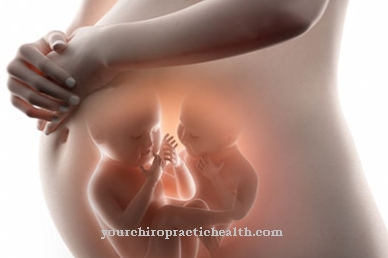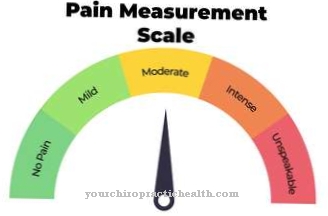As Hepatocellular carcinoma is a tumor disease of the liver. The tumor arises directly from the liver cells.
What is hepatocellular carcinoma?

© Wellnhofer Designs - stock.adobe.com
In medicine it is Hepatocellular carcinoma also as Liver cell cancer or Hepatocellular carcinomaknown. What is meant is a malignant tumor in the liver. In most cases it results from chronic inflammation of the liver or cirrhosis of the liver. While there are no symptoms in the early stages, weight loss and pain in the upper abdomen occur later.
Liver cell carcinoma is more common in men than in women. In Germany, the serious illness is recorded relatively rarely. In contrast, liver cell carcinoma occurs more frequently in Africa and Asia. In the western industrialized countries, liver disease is primarily caused by heavy alcohol consumption. In contrast, infections with hepatitis B and hepatitis C as well as molds have an influence on the development of liver cancer in developing countries.
A distinction is made between three different types of liver cancer. In addition to hepatocellular carcinoma, these are cholangiocellular carcinoma, which develops from the cells of the bile ducts, and angiosarcoma, which develops from the hepatic blood vessels. With a share of around 80 percent, hepatocellular carcinoma is the most common liver cancer variant.
causes
It has not yet been possible to precisely determine what causes liver cell carcinoma. However, there are some known risk factors that can have a positive effect on the disease. These primarily include alcohol consumption and obesity. Otherwise, there are also different risk factors for the three different types of liver cancer.
In the case of hepatocellular carcinoma, this is primarily cirrhosis of the liver, also known as shrunken liver.In most cases, cirrhosis of the liver is caused by chronic viral infections, which include hepatitis B and C. Cirrhosis of the liver and chronic liver inflammation have in common that they cause liver cells to die.
By building new liver cells and connective tissue, the liver tries to make up for the loss. However, if the cells split, there is a risk of genetic code errors. If there is an increased formation of new cells in the diseased liver, this leads to an increased risk of degeneration. This leads to above-average rapid growth and more frequent division of the diseased liver cells. In this way, a tumor is eventually formed.
Mold toxins are also among the risk factors for liver cell carcinoma. Highly toxic aflatoxins with carcinogenic effects are produced from the mold (Aspergillus flavus). The fungus can usually be found in grains or nuts that have grown under poor conditions and have been subjected to moist storage.
In most cases, liver cell carcinoma due to mold toxins occurs in Africa and Asia. Congenital iron metabolism diseases represent a further risk factor. In this process, an excess of iron is absorbed from the organism and deposited in the liver, which ultimately leads to its damage.
Symptoms, ailments & signs
Symptoms of hepatocellular carcinoma appear relatively late. Usually these are unspecific complaints such as loss of appetite, nausea and vomiting. There is also pressure pain in the right upper abdomen, which is due to the capsule tension in the liver.
As the hepatocellular carcinoma progresses, the tumor can also be felt with the hand in the right upper abdomen. Emaciation and ascites are typical symptoms. Other symptoms of hepatocellular carcinoma can be inexplicable weight loss, a general feeling of weakness and jaundice.
Diagnosis & course of disease
As a rule, the complaints lead the patient to the family doctor or an internist. The doctor looks at the patient's medical history and asks whether the family has already had cases of chronic liver inflammation and cirrhosis, whether they have traveled abroad to Africa or Asia and what amounts of alcohol are consumed.
During the physical exam, the doctor pays attention to an enlargement of the liver under the right costal arch. In the case of cirrhosis of the liver, the surface of the liver turns out to be irregular, which can be felt. In addition, the doctor taps the abdomen with his fingers in order to detect water retention in the abdomen.
A blood test can provide further information. The AFP value in the blood serum increases in 50 percent of all patients with liver cell carcinoma. Imaging methods such as computed tomography (CT) or magnetic resonance imaging (MRT), which make the tumor visible and indicate liver cancer metastases, are also important.
It is also possible to take a tissue sample and examine it in the laboratory. Liver cell carcinoma usually turns out badly because it is often discovered late. Without treatment, the patient dies after about six months.
Complications
In many cases, hepatocellular carcinoma is diagnosed very late, meaning that treatment is delayed. In most cases, the patents suffer from nausea or vomiting. There is also a severe loss of appetite and, not infrequently, a significant loss of weight. Pain also occurs in the upper area of the abdomen, which can lead to restrictions in everyday life.
In addition, patients experience significant accumulation of water in their abdomen and a general feeling of weakness. In addition, liver cell carcinoma also leads to jaundice and a greatly reduced resilience of the person affected. As a rule, liver cell carcinoma can only be treated by surgery. In most cases, there are no particular complications.
However, in severe cases, patients need a liver transplant to prevent death. The complications that may arise depend to a large extent on the patient's state of health. Liver cell carcinoma may also significantly reduce the life expectancy of the person affected. Furthermore, chemotherapy is not infrequently necessary, which can continue to lead to various side effects.
When should you go to the doctor?
Nonspecific complaints such as poor appetite and nausea can indicate liver cell carcinoma. The affected person should therefore have the symptoms clarified quickly by a doctor so that appropriate treatment can be initiated without delay. If the symptoms suddenly worsen, see a doctor immediately. The same applies if other side effects of hepatocellular carcinoma occur, such as emaciation and ascites. Other warning signs that should be clarified are jaundice, weakness and recurring attacks of dizziness.
People who suffer from liver disease should consult the responsible specialist in the event of loss of appetite and other unusual symptoms. Other risk groups, such as hepatitis B and C patients and people with a congenital iron metabolism disease, must see a doctor immediately if there are any warning signs. If the cancer is not treated, chronic symptoms can develop. In addition, untreated liver cell carcinoma significantly reduces life expectancy. Therefore, if you suspect that you should consult your family doctor, a hepatologist or a gastroenterologist. In the case of chronic illnesses, a therapist can be involved in the treatment in consultation with the doctor.
Treatment & Therapy
The therapy of hepatocellular carcinoma depends on the stage of the disease. In most cases, an operation has to be performed to remove parts of the liver. In some cases, a liver transplant is also possible, in which the diseased liver is exchanged for a donor organ. The patient's state of health and age also play an important role in treatment.
Destruction of liver cancer tissue can be carried out with laser therapy or radiofrequency therapy. On the other hand, cytostatics respond poorly to hepatocellular carcinoma. Only the tyrosine kinase inhibitor sorafenib is effective. Tumor embolization can be performed for palliative treatment. Local chemotherapy with substances that have a necrotizing effect can also take place.
Outlook & forecast
The prognosis for hepatocellular carcinoma depends on the progress of the disease. The sooner a diagnosis is made and the earlier treatment can begin, the better the prospects of alleviating the existing symptoms. However, it must be taken into account that liver cell carcinoma is often noticed at an advanced stage of the disease. This makes treatment options much more difficult and can contribute to the spread of cancer cells.
With young people, a stable immune system and no other illnesses, recovery can occur. However, complications and further formation of metastases often occur. These worsen the prospect of a cure and can lead to the premature death of the person affected. Since no spontaneous healing is to be expected with this disease, refusal of medical help inevitably leads to the death of the person affected. If a donor organ can be found, the prognosis improves.
While liver transplantation has various risks and side effects, it is a good way to make recovery. If the operation goes without further disturbances and the organism accepts the donor organ well, the carcinoma can be cured. The affected person is nevertheless bound to medical care for the rest of his life and experiences a reduction in physical capacity.
prevention
In order to prevent liver cell carcinoma, it makes sense to refrain from alcohol. In addition, mold should be avoided.
Aftercare
In most cases, follow-up measures for hepatocellular carcinoma prove to be reactive difficult or are not available to the person concerned. The disease must be recognized and treated by a doctor very early on so that there are no further complications in the everyday life of the person affected. If hepatocellular carcinoma is not properly treated, it will in most cases lead to premature death.
In some cases, different drugs can be used to relieve the symptoms of liver cell carcinoma. The person concerned should always pay attention to the correct intake and the correct dosage. If anything is unclear or if you have any questions, you should first consult a doctor, always following the doctor's instructions. However, in many cases, liver cell carcinoma can only be cured with a full liver transplant.
Strict bed rest is required after such a procedure. The person concerned should not carry out any physical or stressful activities in order not to unnecessarily burden the body. The help and support of friends and family can have a very positive effect on the course of the disease. However, liver cell carcinoma significantly reduces the life expectancy of those affected.
You can do that yourself
The treatment of hepatocellular carcinoma is based on the stage of the disease. If the tumor is detected at an early stage, all the patient has to do is follow a healthy and active lifestyle. In conjunction with drug therapy, this is often enough to prevent the cancer from growing further.
Surgical intervention is necessary for larger tumors. The patient can support the recovery by taking it easy after the procedure and following the doctor's instructions regarding diet and hygiene measures. The doctor must be informed if there are complaints or complications. It should also be ensured that the wound is healing well. At the same time, the doctor will refer the patient to an advice center for tumor diseases. Especially in the case of severe disease, it makes sense to talk to a therapist and other people affected.
Liver cell carcinoma can usually be treated well, but there is a relatively high risk of recurrence. The diet should therefore be maintained even after treatment has ended. Above all, luxury foods such as alcohol, nicotine and coffee must be avoided. Regular check-ups must be observed.


.jpg)
.jpg)









.jpg)

.jpg)
.jpg)











.jpg)